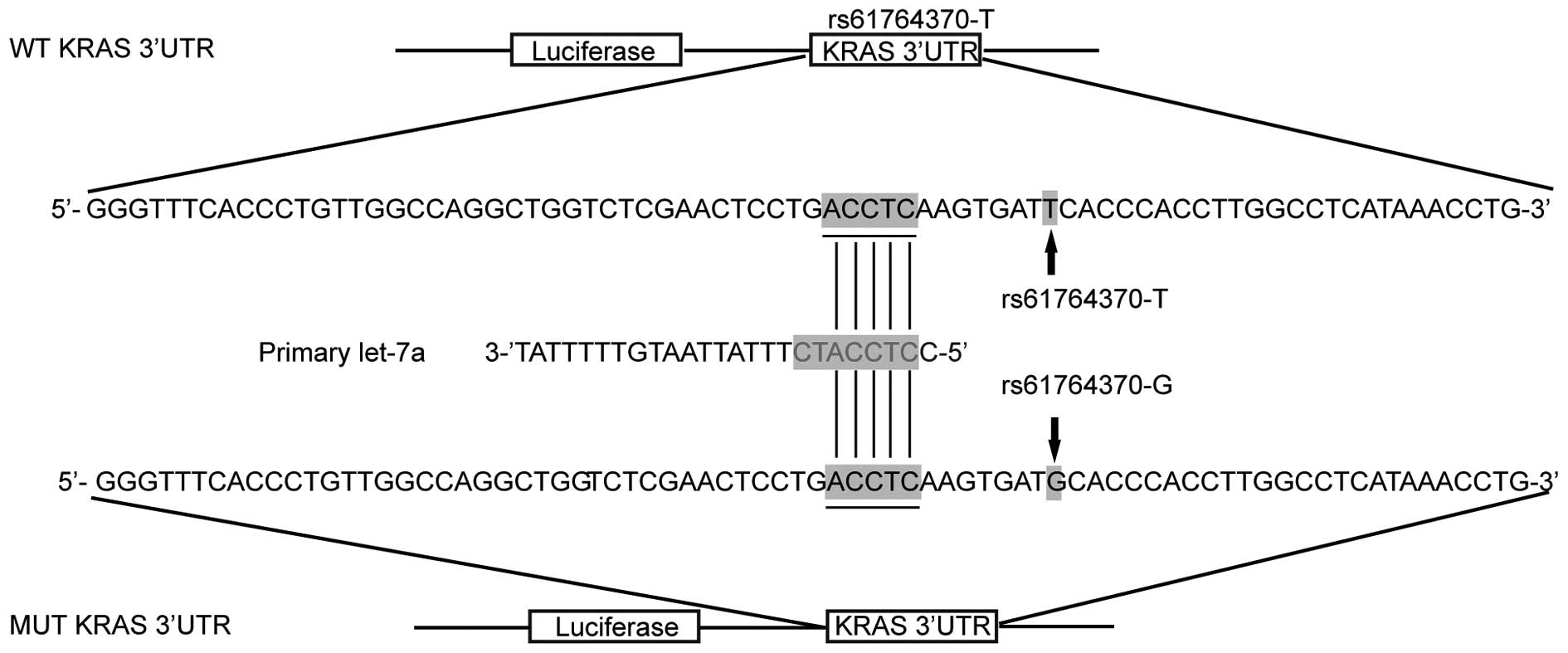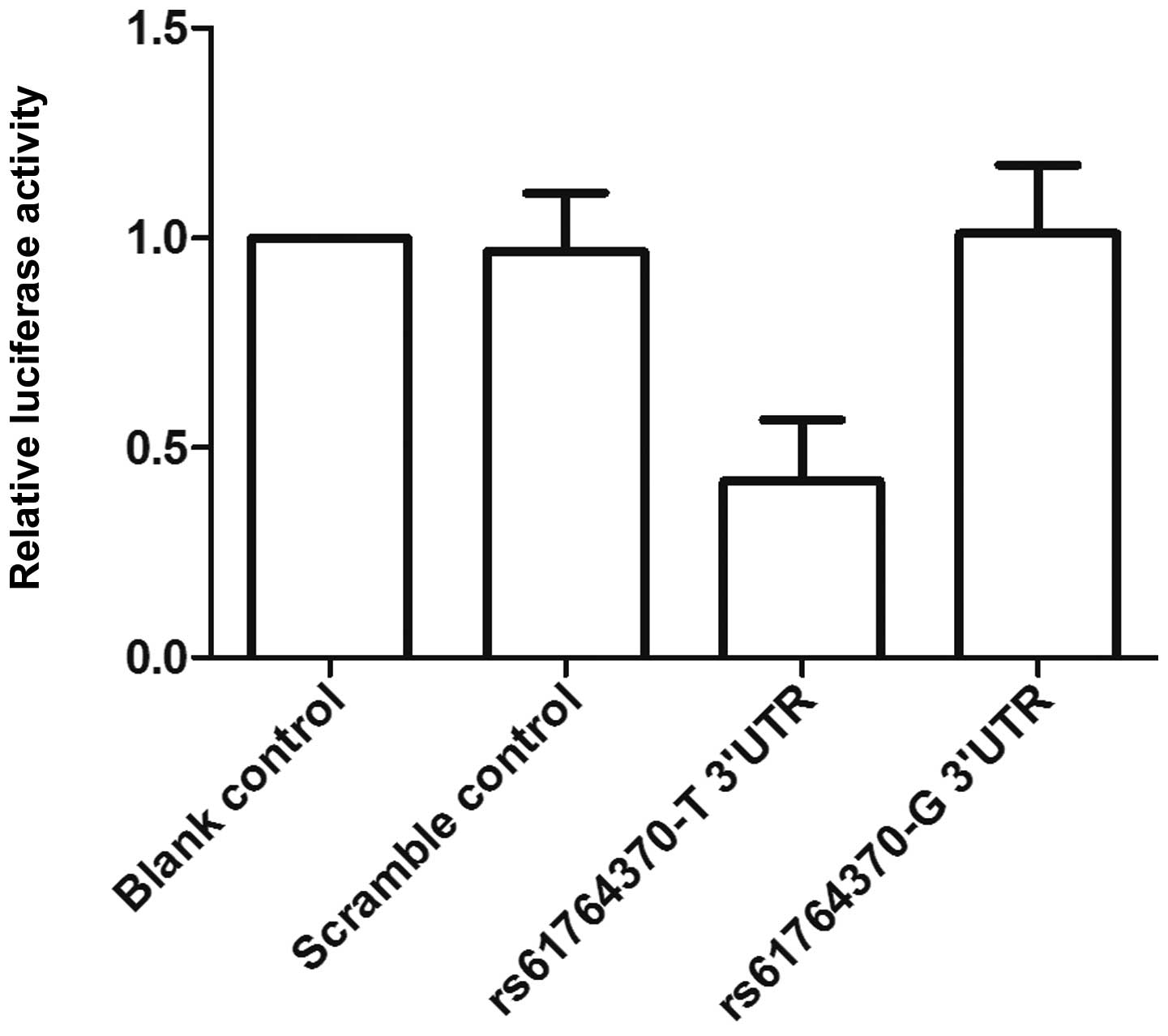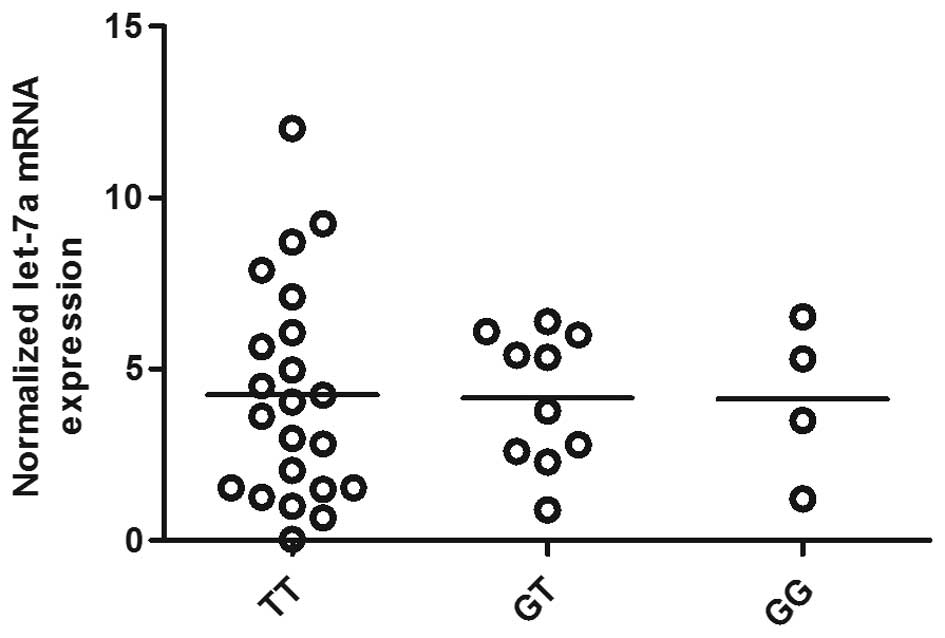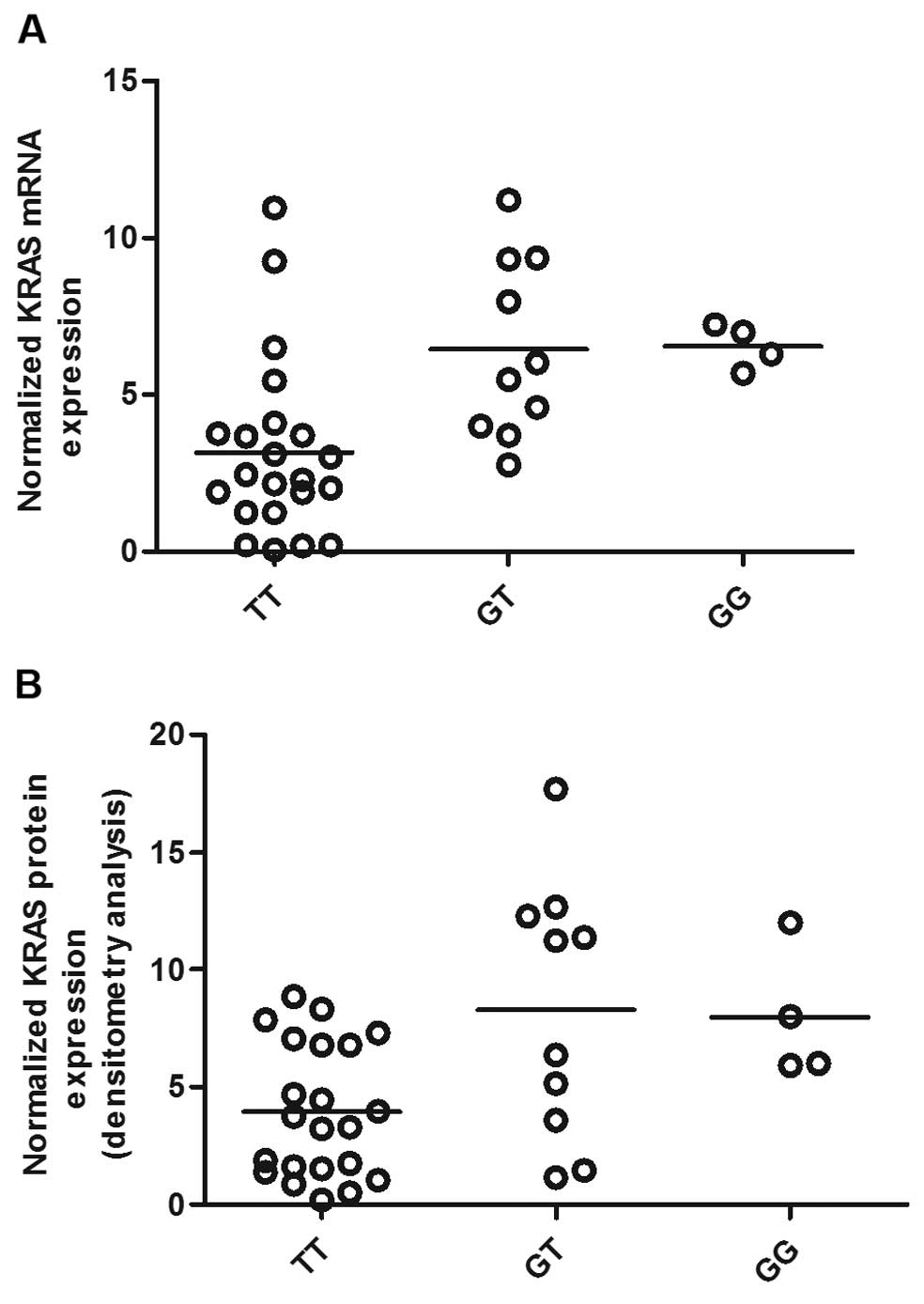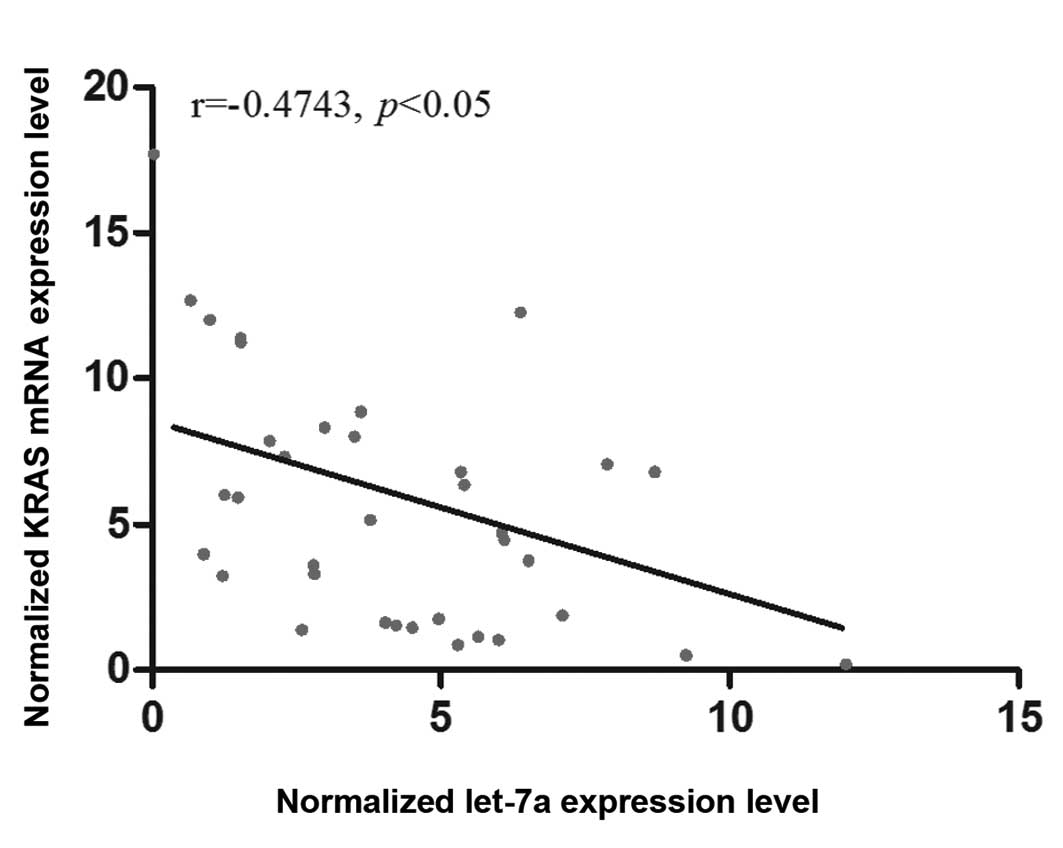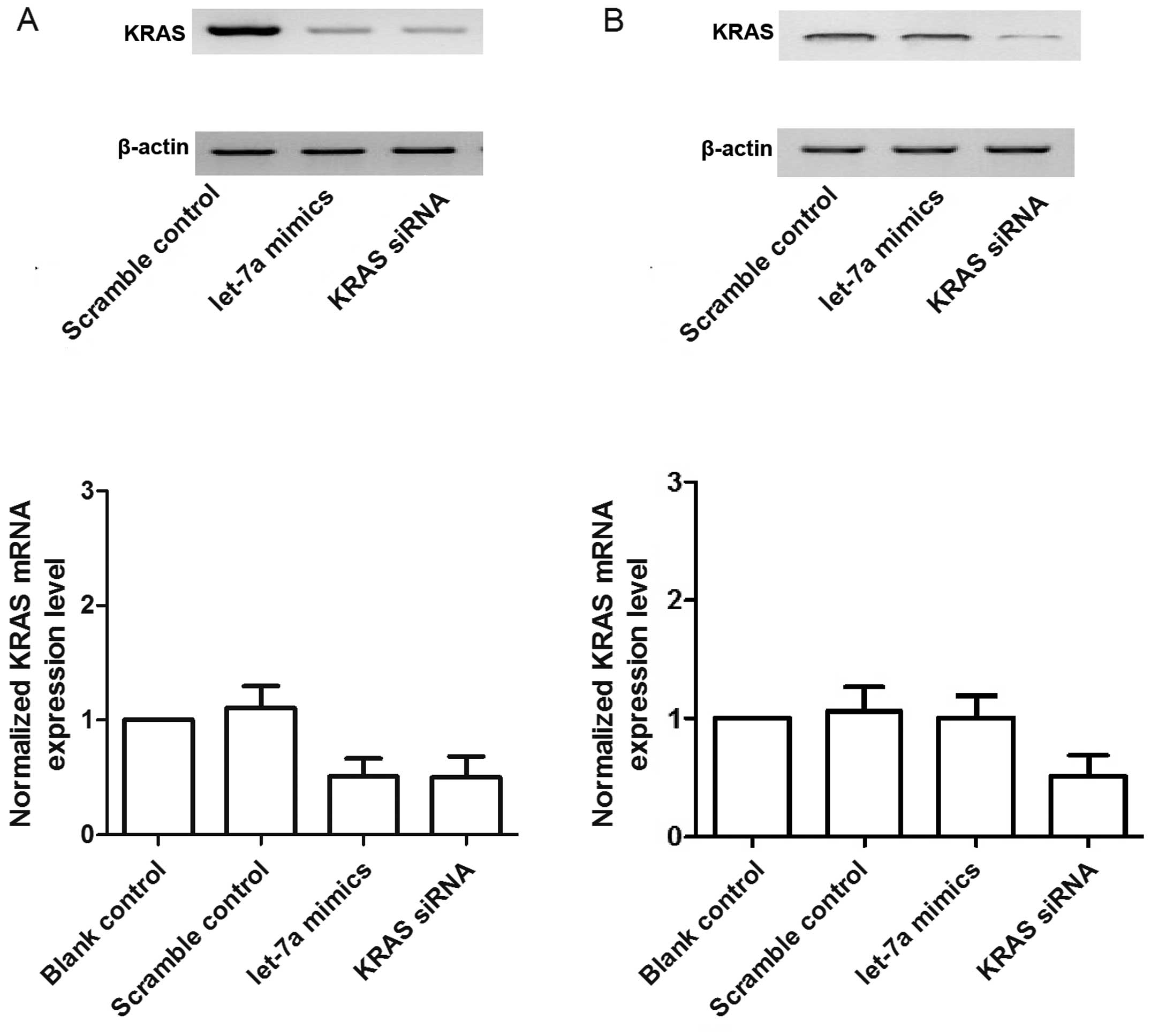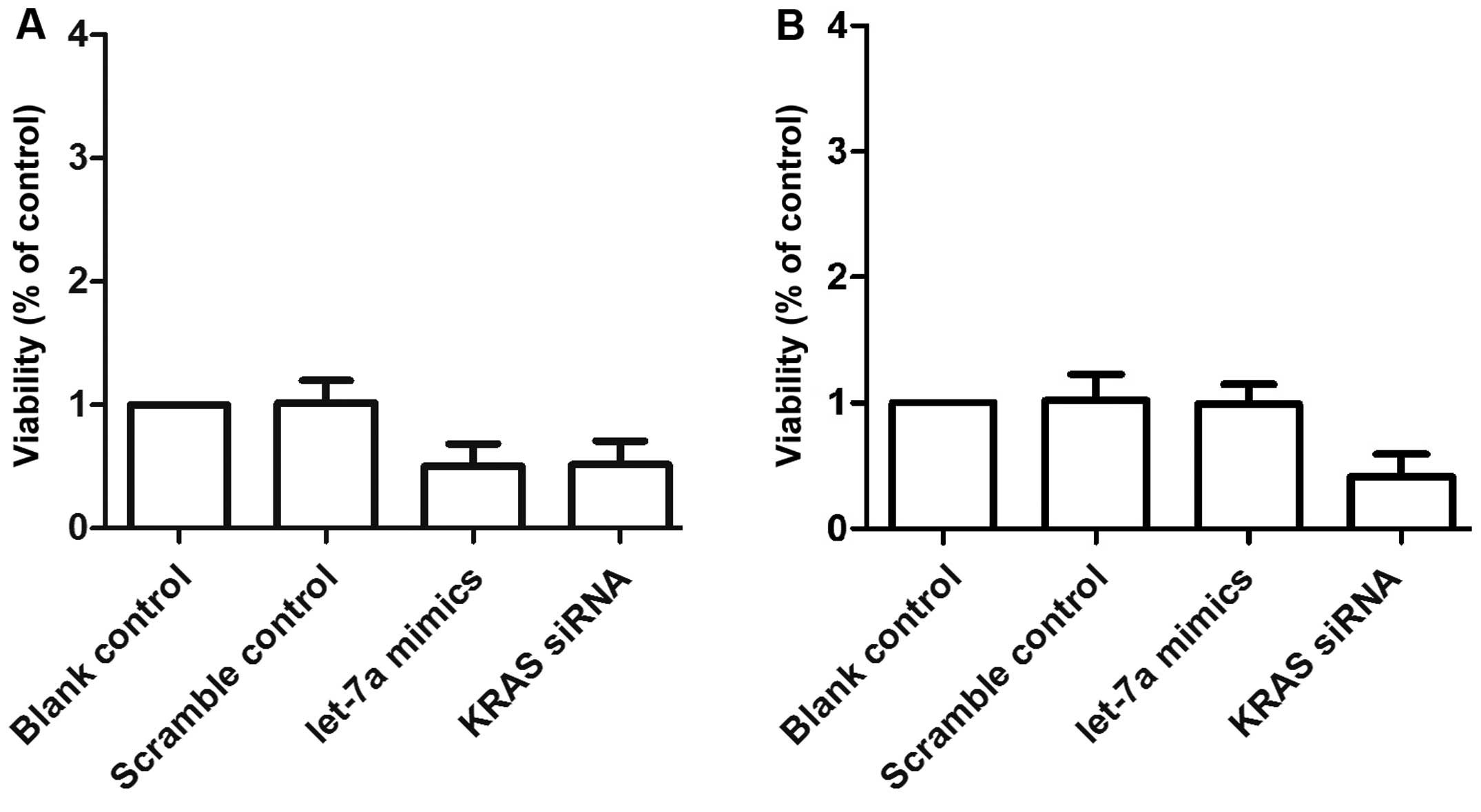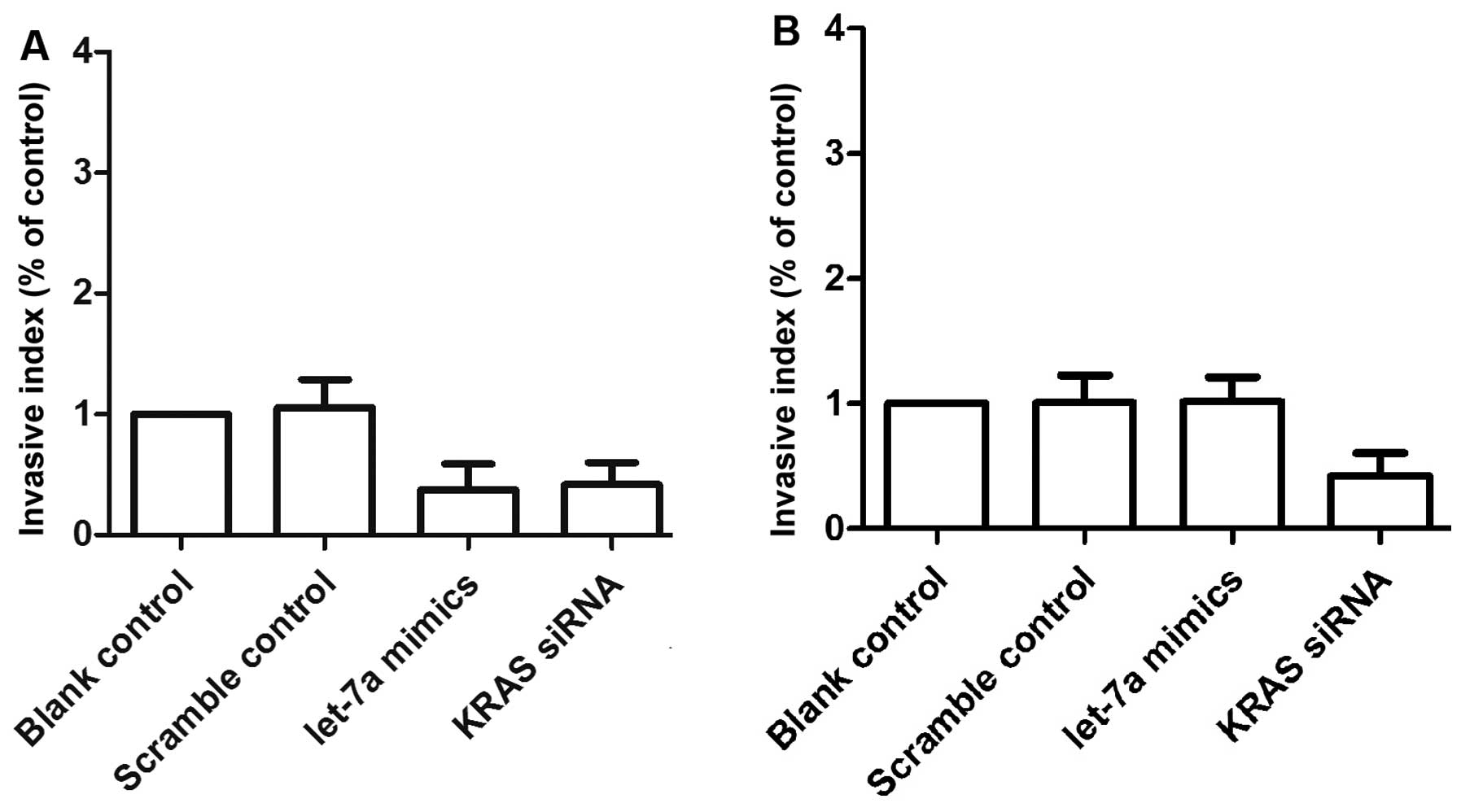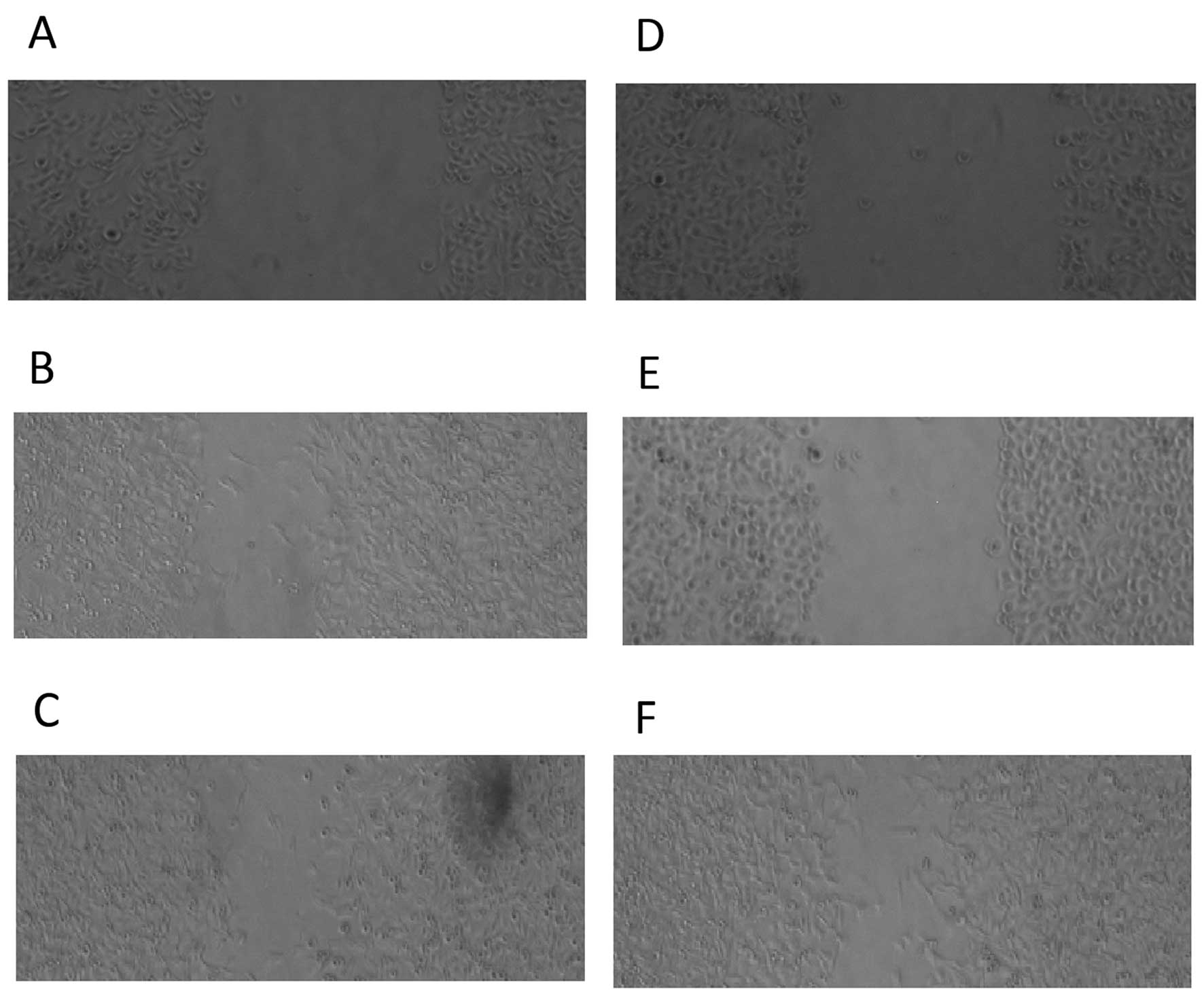A single nucleotide polymorphism in the 3'-untranslated region of the KRAS gene disrupts the interaction with let-7a and enhances the metastatic potential of osteosarcoma cells
- Authors:
- Published online on: July 4, 2016 https://doi.org/10.3892/ijmm.2016.2661
- Pages: 919-926
Abstract
Introduction
Osteosarcoma (OS), which commonly occurs in the developing bones of adolescents and children, is ranked as the most frequent primary bone malignancy (1). At present, adjuvant chemotherapy, radiotherapy and surgery are the principal treatments for OS (2). The overall survival rate and 5 year survival rate are approximately 60% despite the fact that remarkable advances have been achieved with chemotherapy (2,3). Furthermore, drug resistance frequently develops in OS and the use of chemotherapeutic drugs is restricted by dose-limiting toxicity (3). Despite the administration of combination therapy (surgery combined with chemotherapy regimens using multiple agents), nearly one third of patients with OS characterized by localized lesions at the time of diagnosis suffered relapse (4) and lung metastases contributed to 90% of relapses. Sixty to seventy percent of patients with non-metastatic OS receiving conventional therapy have achieved 5-year survival and some individuals have reached two decades (5) whereas the long-term survival rate of patients with recurrent or metastatic malignancy is <20% (6).
MicroRNAs (miRNAs) are a class of small, non-coding RNAs, which bind to the 3′-untranslated region (3′-UTR) of target mRNAs in order to suppress the expression of genes. Alterations in miRNA expression have been associated with the metastasis, progression and initiation of malignancy. Previous findings have demonstrated that miRNAs may serve as oncogenes or tumor suppressors during the development of cancer (7,8). Previous findings have indicated that miRNAs play an essential role in the progression and pathogenesis of OS (9).
Non-coding polymorphisms associated with treatment response, prognosis and cancer risk which involve common dysregulated signaling pathways, such as the phosphoinositide 3-kinase (PI3K)/AKT pathways or the mitogen-activated protein kinase (MAPK) pathway, may serve as critical starting points for the functional validation and assessment of such polymorphisms in understanding the initiation, progression and metastasis of various malignancies (10). Researchers have explored the involvement of a silent polymorphism rs61764370, which is situated in the 3′-UTR of Kirsten rat sarcoma viral oncogene homolog (KRAS), one of the most commonly mutated oncogenes in the development of malignancy (11). Tentative bioinformatic and biochemical analysis indicated that the miRNA let-7 binding site was weakened by rs61764370 T>G variant, which led to the increased expression of KRAS (12). Previous studies have reported that let-7g, another member of the let-7 family, is functionally involved in controlling the metastasis of OS (13); moreover, the dysregulation of the KRAS signaling pathway was believed to be responsible for the metastasis of OS (14). By contrast, KRAS has been identified as a direct target gene of let-7a in lung cancer cells and colon cancer cells (15,16,17). Based on computational analysis (http://mirtarbase.mbc.nctu.edu.tw/), the rs61764370 polymorphism was found to be located close to the putative binding site of let-7a in the 3′-UTR of KRAS, and we therefore hypothesized that the rs61764370 polymorphism may be associated with an increased risk of metastatic disease in OS by disrupting the interaction between let-7a and KRAS mRNA.
Materials and methods
Study population and tissue samples
A total of 36 surgically resected OS tissue specimens were obtained (prior to the administration of neoadjuvant chemotherapy) from the Department of Orthopedic Surgery at the First Affiliated Hospital of Harbin Medical University (Harbin, China). Written informed consent was obtained from all patients, and the present study was approved by the Ethics Committee of Harbin Medical University (Harbin, China).
DNA extraction and sequence analysis
Genomic DNA was extracted using a DNA extraction kit (Promega, Fitchburg, WI, USA). DNA quality and quantity was assessed using the Nanodrop 1000 (Thermo Fisher Scientific, Waltham, MA, USA). The T>G variant at the single nucleotide polymorphism (SNP) rs61764370 was verified by the purification of the PCR product amplified with forward primer, 5′-TTTTGGGGTGGTGGTGTGCCAA-3′ and reverse primer, 5′-AGTCACCACACAAGGCACTG-3′ and sequenced using the forward primer. Sequencing and mutational analysis was performed.
Cell culture and transfection
Two OS cell cultures, which were genotyped as rs61764370 TT (named as OSTT) and TG (named as OSTG), were derived from the biopsies obtained from the Department of Orthopedic Surgery at the First Affiliated Hospital of Harbin Medical University (Harbin, China) in accordance with the protocol approved by the Ethics Committee of Harbin Medical University. The MG-63 cell line was purchased from the American Type Culture Collection (ATCC; Manassas, VA, USA) and maintained in Dulbecco's modified Eagle's medium (DMEM)/F12 (HyClone, Logan, UT, USA) supplemented with 10% fetal bovine serum (Gibco, Grand Island, NY, USA). We obtained scramble RNA, let-7a mimics (5′-AGUGGGGAACCCUUCCAUGAGG-3′) and KRAS siRNA (5′-AGTACTGGCGATTCTCTGA GGC-3′) from GenePharma (Shanghai, China). The transfection of cells with blank control (no RNA was transfected), scramble control, let-7a mimics and KRAS siRNA was performed using Lipofectamine 2000 (Invitrogen Life Technologies, Carlsbad, CA, USA).
Wound-healing assay
A 6-well plate was used to culture OSTT and OSGG cells. After 24 h, when the cells reached 80–90% confluence, we removed the attached cells with a sterile plastic pipette tip to create a single wound in the center of the well. Serum-free medium was used to remove the debris. An inverted microscope (IX83; Olympus, Tokyo, Japan) was employed to visualize and capture images of the cells which had migrated into the wounded area after 24 h of culturing. Each experiment was performed independently at least three times.
Dual luciferase assay
The full length of the KRAS 3′-UTR was subcloned into the pmirGLO vector (Promega, Madison, WI, USA) to generate the luciferase reporter vector. The MG-63 cells were seeded in 48-well plates at a density of 1×104 cells/well. Let-7a mimics and luciferase reporter vectors were co-transfected using Lipofectamine 2000 (Invitrogen Life Technologies). After 48 h, the cells were harvested and assayed for luciferase activity using the Dual-Luciferase Reporter Assay system (Promega) according to the manufacturer's instructions. The firefly luciferase activities were normalized to Renilla luciferase activity. Each treatment was performed in triplicate in three independent experiments.
3-(4,5-Dimethylthiazol-2-yl)-2,5-diphenyltetrazolium bromide (MTT) assay
The viability of the cells was measured using an MTT assay according to the manufacturer's instructions (Sigma, St. Louis, MO, USA). Briefly, the cells were seeded at a density of 2,000 cells/well in 96-well plates containing 100 µl culture medium and incubated overnight. To each well, 20 µl of 5 mg/ml MTT was added and the plates were incubated for an additional 4 h at 37°C. After removing the medium, the formazan complex was solubilized with 100 µl dimethyl sulfoxide (DMSO; Sigma). Optical density (OD) was determined by measuring the absorbance at a test wavelength of 490 nm and a reference wavelength of 630 nm. Wells without cells (DMSO alone) were used as blanks. Each group contained six wells; experiments were repeated three times independently and the results are expressed as the means ± standard deviation.
Reverse transcription-quantitative polymerase chain reaction (RT-qPCR)
Forty-eight hours after transfection, the total RNA (including miRs) was extracted using an miRNANeasy Mini kit (Qiagen, Hilden, Germany) according to the manufacturer's instructions. The concentration of RNA was measured using a Beckman DU-640 spectrophotometer (Beckman Coulter, Inc., Fullerton, CA, USA). The quality of RNA was determined by 1% formaldehyde-agarose gel electrophoresis. PCR amplification for the quantification of let-7a and KRAS mRNA was performed using a TaqMan® miRNA reverse transcription kit and TaqMan miRNA assay kits (both from Applied Biosystems, Foster City, CA, USA). The following PCR protocol was used: 40 cycles at 95°C for 15 sec, 60°C for 15 sec and 72°C for 30 sec on a real-time PCR system (Applied Biosystems). RNU48 (Applied Biosystems) was used as the endogenous control. The relative gene expression levels were then normalized to RNU48 and calculated using the 2−ΔΔCT method.
Western blot analysis
Proteins were extracted from the transfected cells or the tissue samples using radioimmunoprecipitation assay (RIPA) lysis buffer (Upstate Biotechnology, Inc., Lake Placid, NY, USA). The protein level was determined using protein assay reagents (Bio-Rad Laboratories, Hercules, CA, USA) according to standard protocols. Briefly, 25 µg of total protein was loaded onto a 12% PAGE gel (NuPAGE; Invitrogen Life Technologies) and subjected to electrophoresis. After blotting onto pure nitrocellulose membranes (Bio-Rad Laboratories) the proteins were blocked with Odyssey® Blocking Buffer (LI-COR Biosciences, Lincoln, NE, USA) for 2 h. Subsequently, the membranes were incubated in primary antibodies buffer (primary antibodies, Odyssey Blocking Buffer, 0.1% Tween®-20) overnight at 4°C. The primary antibodies, KRAS and β-actin were purchased from Cell Signaling Technology, Inc. (Beverly, MA, USA). The following day, the membranes were washed four times for 5 min in Tris-buffered saline and Tween-20 (TBST). Finally, the membranes were incubated with secondary antibodies, goat anti-rabbit lgG (Cell Signaling Technology, Inc.). The blots were then treated with an ECL kit and the relative density of the target bands was calculated using ImageJ software (National Institutes of Health, Bethesda, MD, USA).
Transwell migration assay
After transfection, the OSTT or OSGG cells (5×103) were suspended in serum-free medium and seeded onto the upper part of the chamber for the cell migration assay. Complete medium with 20% serum was added to the lower chamber as a chemoattractant. After 48 h, the Transwell membrane was fixed with methanol, and the cells that had migrated to the lower surface of the filters were stained with 0.1% crystal violet stain solution (Sigma). Migration was determined by counting the cell number under a microscope (Olympus). The average number of migrating cells in five random fields was taken as the cell migration number of the group.
Statistical analysis
All statistical analyses were performed using SPSS 17.0 (SPSS, Inc., Chicago, IL, USA). Comparison of datasets for each cell group was performed using the independent t-test or one-way ANOVA, applying Bonferonni's multiple comparison test. A P-value <0.05 was considered to indicate a statistically significant difference. The values reported correspond to the means ± standard deviation.
Results
Effect of rs61764370 polymorphism on the interaction between the KRAS 3′-UTR and let-7a in OS cells
It has been previously shown that KRAS was a target of let-7a in human cells (15–17). Based on computational analysis, the KRAS 3′-UTR rs61764370 polymorphism was found to be located in the flanking sequence close to the predicted 'binding site' for let-7a (Fig. 1). To determine whether let-7a targets KRAS 3′-UTR in OS cells, we constructed reporter vectors carrying wild-type or mutant KRAS 3′-UTR, as described in Fig. 1. Subsequently, we used them for transient transfection of the OS cells with let-7a mimics or scrambled controls. As shown in Fig. 2, only the luciferase activity from the cells cotransfected with wild-type KRAS 3′-UTR and let-7a mimics decreased by 50% compared with the control, and all other groups were comparable. The results confirmed that KRAS is a validated target of let-7a in OS cells, and the rs61764370 polymorphism compromised the interaction between let-7a and KRAS 3′-UTR, and the nucleotide substitution completely abrogated the miRNA/mRNA interaction in OS cells.
Determination of let-7a and KRAS expression in OS tissues of different genotypes
The OS tissues of three different genotypes (TT, n=22, GT, n=10, GG, n=4) were used to further explore the impact of the polymorphism on the interaction between let-7a and KRAS 3′-UTR. Using RT-qPCR, we found that let-7a expression was comparable among the TT, GT and GG groups (Fig. 3). Additionally, to characterize the effect of KRAS 3′-UTR rs61764370 polymorphism on the miRNA/mRNA interaction in OS cells, which plays a central role in the development of OS, we quantified the expression of KRAS using RT-qPCR as well as western blot analysis. As shown in Fig. 3, the expression of let-7a was similarly distributed among each genotype group, whereas in Fig. 4 the mRNA and protein expression of KRAS in the TT genotype group was significantly lower than that in the GT and GG groups. We then analyzed the correlation between the mRNA expression of let-7a and KRAS among the OS tissues (n=36), and found a negative correlation between them (Fig. 5).
To further validate the hypothesis of the negative regulatory relationship between let-7a and KRAS and to explore the effect of the polymorphism in such a relationship, we examined the mRNA/protein expression of KRAS in two primary OS cell cultures which were genotyped as TT (OSTT) and TG (OSTG). We transfected the two OS cell groups with either scrambled control, let-7a mimics or KRAS siRNA. As shown in Fig. 6A and C, the mRNA and protein expression of KRAS in the OSTT cells treated with let-7a mimics and KRAS siRNA was lower than that in the scrambled control. The OSTG cells treated with KRAS siRNA showed substantial downregulation of the mRNA and protein expression of KRAS whereas let-7a mimics exerted minimal effects on the expression of KRAS compared with the control (Fig. 6B).
Let-7a and KRAS affect the viability of OS cells
We also examined the relative viability of OS cells following transfection with either scrambled control, let-7a mimics or KRAS siRNA. The OSTT cells transfected with let-7a mimics and KRAS siRNA showed comparably lower viability compared with the scrambled control group. The viability of the OSTG cells was comparable between the scrambled control and the let-7a mimic group, and the viability of both groups was notably higher than that of KRAS siRNA group (Fig. 7A and B).
Let-7a and KRAS interfer with the invasiveness and migratory ability of OS cells
We also examined the relative invasion (Fig. 8) and migration (Fig. 9) of the two primary OS cell cultures following transfection with either scrambled control, let-7a mimics or KRAS siRNA. The invasiveness (Fig. 8A) and migratory ability (Fig. 9A–C) of the OSTT cells transfected with KRAS siRNA and let-7a mimics was notably downregulated when compared with the scrambled controls. The OSTG cells transfected with let-7a mimics and scramble controls showed comparable invasiveness and migratory abilities which were markedly higher compared with the OSTG cells treated with KRAS siRNA (Fig. 8B and Fig. 9D–F).
Discussion
As the first member of the miRNA family to be identified, let-7a has been reported to negatively regulate RAS expression (18). Currently, numerous in vitro and in vivo studies have identified members of the let-7 family to be suppressors of tumor cell proliferation (19). There are 12 miRNAs in the let-7 family in humans, including let-7a which has been confirmed to be closely associated with the prognosis of patients with lung cancer; low let-7a miRNA levels usually correlate with low survival rates (20) implying that let-7a may inhibit the metastasis, invasion and proliferation of lung cancer cells. Target genes of let-7a include c-Myc, the high-mobility group AT-Hook 2 (HMGA2) which takes part in cell differentiation and proliferation, the RAS family, cyclin D2, cyclin-dependent kinase 6 (CDK6) and cell division cycle 25A (CDC25A) (21). In the present study, we confirmed that KRAS is a target of let-7a in OS cells, and the introduction of rs61764370 minor allele into the 3′-UTR of KRAS significantly compromised the miRNA/mRNA interaction using a luciferase reporter system.
The major RAS signaling pathway consists of the mTOR/Akt/PI3K/Ras, p38-MAPK/MEK/Raf/Ras, and ERK/MEK/Raf/Ras pathways. Overactivation of the ERK/MEK/Raf/Ras pathway has been reported to account for the lung metastasis of OS in a mouse model (22). Some researchers believed that the three Ras signaling pathways function in different ways. Cancer cell differentiation may be promoted by the MEK/p38 pathway. The Ras/PI3K/Akt pathway may protect cells against apoptosis (23). By contrast, the ERK/MEK/Raf/Ras pathway plays roles in metastasis, tumourigenesis, and the epithelial-mesenchymal transition (EMT) (24), and it is essential in many stages of cancer metastasis such as the regulation of angiogenesis/endothelial apoptosis (25), the EMT, the production of proteases such as matrix metallopeptidase 9 (MMP-9) and the expression of integrin receptors binding extracellular matrix proteins (26). The ERK/MEK/Raf/Ras pathway has been shown to be upregulated in approximately 50% of metastatic tumours (27). Significant correlations between the presence of lymph node metastases and the expression of activated MEK/ERK were demonstrated by cohort studies of breast carcinomas (28). In this study, we analyzed the correlation between the mRNA expression of let-7a and KRAS among the OS tissues (n=35), and found a negative correlation between them. In addition, we also showed that let-7a expression was similar among each genotype group whereas the mRNA and protein expression of KRAS in the TT genotype group was significantly lower than that in the GT and GG groups.
Previous studies have noted that the polymorphism acts as a marker for an increased risk of developing various types of malignancies such as ovarian carcinoma (29), non-small cell lung cancer (NSCLC) (30) and triple-negative breast cancer (12). Furthermore, some variants have also been identified as adverse prognostic indicators in some types of cancer (31). Variants that are associated with miRNA have been reported in both pre-miRNA and 3′-UTR of the target gene. The one located in the pre- or pri-miRNA may compromise the generation of mature miRNA by interfering with the mature processing, undermining its secondary structure, or alternating the arm selection during the production of the miRNA (32). However, the variants in the UTR of the target genes may abolish or attenuate the inhibitory effect of miRNA on mRNA of the target by disrupting the binding or interaction between the miRNA and mRNA (33). KRAS 3′-UTR rs61764370 has been shown to be associated with some cancer phenotypes, such as prognosis in rectal cancer (34), and response to chemotherapy in colorectal cancer (35). Its involvement in some other types of cancer has been ruled out (36). In the present study, we reported that the mRNA and protein expression of KRAS in the OSTT cells treated with let-7a mimics and KRAS siRNA was lower than that in the scrambled control. The OSTG cells treated with KRAS siRNA showed substantial downregulation of the mRNA and protein expression of KRAS whereas let-7a mimics exerted minimal effects on KRAS expression compared with the control. Moreover, the OSTT cells transfected with KRAS siRNA and let-7a mimics exibited a notable decrease in invasiveness (fig. 8A) and migratory ability (fig. 9A–C) when compared with the scrambled controls. The OSTG cells transfected with let-7a mimics and scrambled controls exhibited comparable invasiveness and migratory abilitiy, which were markedly higher than that of the OSTG cells treated with KRAS siRNA.
Taken together, these findings suggest that the protein expression of KRAS is markedly affected by variant rs61764370 which may explain its role in controlling the metastasis of OS. Therefore, the rs61764370 polymorphism may function as a predictive biomarker or therapeutic target in the management of OS.
References
|
Arndt CA and Crist WM: Common musculoskeletal tumors of childhood and adolescence. N Engl J Med. 341:342–352. 1999. View Article : Google Scholar : PubMed/NCBI | |
|
Bielack SS, Marina N, Ferrari S, Helman LJ, Smeland S, Whelan JS and Reaman GH: Osteosarcoma: the same old drugs or more? J Clin Oncol. 26:3102–3103; author reply 3104–3105. 2008. View Article : Google Scholar : PubMed/NCBI | |
|
Gill J, Ahluwalia MK, Geller D and Gorlick R: New targets and approaches in osteosarcoma. Pharmacol Ther. 137:89–99. 2013. View Article : Google Scholar | |
|
Longhi A, Errani C, De Paolis M, Mercuri M and Bacci G: Primary bone osteosarcoma in the pediatric age: state of the art. Cancer Treat Rev. 32:423–436. 2006. View Article : Google Scholar : PubMed/NCBI | |
|
Ferrari S and Palmerini E: Adjuvant and neoadjuvant combination chemotherapy for osteogenic sarcoma. Curr Opin Oncol. 19:341–346. 2007. View Article : Google Scholar : PubMed/NCBI | |
|
Ritter J and Bielack SS: Osteosarcoma. Ann Oncol. 21(Suppl 7): vii320–vii325. 2010. View Article : Google Scholar : PubMed/NCBI | |
|
Bang YJ: Advances in the management of HER2-positive advanced gastric and gastroesophageal junction cancer. J Clin Gastroenterol. 46:637–648. 2012. View Article : Google Scholar : PubMed/NCBI | |
|
Nicoloso MS, Spizzo R, Shimizu M, Rossi S and Calin GA: MicroRNAs - the micro steering wheel of tumour metastases. Nat Rev Cancer. 9:293–302. 2009. View Article : Google Scholar : PubMed/NCBI | |
|
Xu JQ, Liu P, Si MJ and Ding XY: MicroRNA-126 inhibits osteosarcoma cells proliferation by targeting Sirt1. Tumour Biol. 34:3871–3877. 2013. View Article : Google Scholar : PubMed/NCBI | |
|
Zhang L, Yuan X, Chen Y, Du XJ, Yu S and Yang M: Role of EGFR SNPs in survival of advanced lung adenocarcinoma patients treated with gefitinib. Gene. 517:60–64. 2013. View Article : Google Scholar : PubMed/NCBI | |
|
Prior IA, Lewis PD and Mattos C: A comprehensive survey of Ras mutations in cancer. Cancer Res. 72:2457–2467. 2012. View Article : Google Scholar : PubMed/NCBI | |
|
Paranjape T, Heneghan H, Lindner R, Keane FK, Hoffman A, Hollestelle A, Dorairaj J, Geyda K, Pelletier C, Nallur S, et al: A 3′-untranslated region KRAS variant and triple-negative breast cancer: a case-control and genetic analysis. Lancet Oncol. 12:377–386. 2011. View Article : Google Scholar : PubMed/NCBI | |
|
Liu JM, Long XH, Zhang GM, Zhou Y, Chen XY, Huang SH, Liu ZL and Zhang ZH: Let-7g reverses malignant phenotype of osteosarcoma cells by targeting Aurora-B. Int J Clin Exp Pathol. 7:4596–4606. 2014.PubMed/NCBI | |
|
Pignochino Y, Grignani G, Cavalloni G, Motta M, Tapparo M, Bruno S, Bottos A, Gammaitoni L, Migliardi G, Camussi G, et al: Sorafenib blocks tumour growth, angiogenesis and metastatic potential in preclinical models of osteosarcoma through a mechanism potentially involving the inhibition of ERK1/2, MCL-1 and ezrin pathways. Mol Cancer. 8:1182009. View Article : Google Scholar : PubMed/NCBI | |
|
He XY, Chen JX, Zhang Z, Li CL, Peng QL and Peng HM: The let-7a microRNA protects from growth of lung carcinoma by suppression of k-Ras and c-Myc in nude mice. J Cancer Res Clin Oncol. 136:1023–1028. 2010. View Article : Google Scholar | |
|
Wang YY, Ren T, Cai YY and He XY: MicroRNA let-7a inhibits the proliferation and invasion of nonsmall cell lung cancer cell line 95D by regulating K-Ras and HMGA2 gene expression. Cancer Biother Radiopharm. 28:131–137. 2013. View Article : Google Scholar | |
|
Luu C, Heinrich EL, Duldulao M, Arrington AK, Fakih M, Garcia-Aguilar J and Kim J: TP53 and let-7a micro-RNA regulate K-Ras activity in HCT116 colorectal cancer cells. PLoS One. 8:e706042013. View Article : Google Scholar : PubMed/NCBI | |
|
Johnson SM, Grosshans H, Shingara J, Byrom M, Jarvis R, Cheng A, Labourier E, Reinert KL, Brown D and Slack FJ: RAS is regulated by the let-7 microRNA family. Cell. 120:635–647. 2005. View Article : Google Scholar : PubMed/NCBI | |
|
Kumar MS, Erkeland SJ, Pester RE, Chen CY, Ebert MS, Sharp PA and Jacks T: Suppression of non-small cell lung tumor development by the let-7 microRNA family. Proc Natl Acad Sci USA. 105:3903–3908. 2008. View Article : Google Scholar : PubMed/NCBI | |
|
Takamizawa J, Konishi H, Yanagisawa K, Tomida S, Osada H, Endoh H, Harano T, Yatabe Y, Nagino M, Nimura Y, et al: Reduced expression of the let-7 microRNAs in human lung cancers in association with shortened postoperative survival. Cancer Res. 64:3753–3756. 2004. View Article : Google Scholar : PubMed/NCBI | |
|
Lee YS and Dutta A: The tumor suppressor microRNA let-7 represses the HMGA2 oncogene. Genes Dev. 21:1025–1030. 2007. View Article : Google Scholar : PubMed/NCBI | |
|
Yu Y, Luk F, Yang JL and Walsh WR: Ras/Raf/MEK/ERK pathway is associated with lung metastasis of osteosarcoma in an orthotopic mouse model. Anticancer Res. 31:1147–1152. 2011.PubMed/NCBI | |
|
Song L, Xiong H, Li J, Liao W, Wang L, Wu J and Li M: Sphingosine kinase-1 enhances resistance to apoptosis through activation of PI3K/Akt/NF-κB pathway in human non-small cell lung cancer. Clin Cancer Res. 17:1839–1849. 2011. View Article : Google Scholar : PubMed/NCBI | |
|
Shirakihara T, Horiguchi K, Miyazawa K, Ehata S, Shibata T, Morita I, Miyazono K and Saitoh M: TGF-β regulates isoform switching of FGF receptors and epithelial-mesenchymal transition. EMBO J. 30:783–795. 2011. View Article : Google Scholar : PubMed/NCBI | |
|
Nakabayashi H and Shimizu K: HA1077, a Rho kinase inhibitor, suppresses glioma-induced angiogenesis by targeting the Rho-ROCK and the mitogen-activated protein kinase kinase/extracellular signal-regulated kinase (MEK/ERK) signal pathways. Cancer Sci. 102:393–399. 2011. View Article : Google Scholar | |
|
Halaban R, Zhang W, Bacchiocchi A, Cheng E, Parisi F, Ariyan S, Krauthammer M, McCusker JP, Kluger Y and Sznol M: PLX4032, a selective BRAF (V600E) kinase inhibitor, activates the ERK pathway and enhances cell migration and proliferation of BRAF melanoma cells. Pigment Cell Melanoma Res. 23:190–200. 2010. View Article : Google Scholar : PubMed/NCBI | |
|
Wellbrock C, Karasarides M and Marais R: The RAF proteins take centre stage. Nat Rev Mol Cell Biol. 5:875–885. 2004. View Article : Google Scholar : PubMed/NCBI | |
|
Sivaraman VS, Wang H, Nuovo GJ and Malbon CC: Hyperexpression of mitogen-activated protein kinase in human breast cancer. J Clin Invest. 99:1478–1483. 1997. View Article : Google Scholar : PubMed/NCBI | |
|
Pharoah PD, Palmieri RT, Ramus SJ, Gayther SA, Andrulis IL, Anton-Culver H, Antonenkova N, Antoniou AC, Goldgar D, Beattie MS, et al: The role of KRAS rs61764370 in invasive epithelial ovarian cancer: implications for clinical testing. Clin Cancer Res. 17:3742–3750. 2011. View Article : Google Scholar : PubMed/NCBI | |
|
Chin LJ, Ratner E, Leng S, Zhai R, Nallur S, Babar I, Muller RU, Straka E, Su L, Burki EA, et al: A SNP in a let-7 microRNA complementary site in the KRAS 3′ untranslated region increases non-small cell lung cancer risk. Cancer Res. 68:8535–8540. 2008. View Article : Google Scholar : PubMed/NCBI | |
|
Nelson HH, Christensen BC, Plaza SL, Wiencke JK, Marsit CJ and Kelsey KT: KRAS mutation, KRAS-LCS6 polymorphism, and non-small cell lung cancer. Lung Cancer. 69:51–53. 2010. View Article : Google Scholar : | |
|
Jia Y, Zang A, Shang Y, Yang H, Song Z, Wang Z, Ren L, Wei Y, Hu L, Shi H and Li H: MicroRNA-146a rs2910164 polymorphism is associated with susceptibility to non-small cell lung cancer in the Chinese population. Med Oncol. 31:1942014. View Article : Google Scholar : PubMed/NCBI | |
|
Kong Y, Wu JB, Wang X, Zhao JF, Song H and Yuan LD: Polymorphism of the OLR1 3′ UTR potential microRNA binding site and risk of Alzheimer's disease: a meta-analysis. Genet Mol Res. 13:10162–10172. 2014. View Article : Google Scholar : PubMed/NCBI | |
|
Sclafani F, Chau I, Cunningham D, Peckitt C, Lampis A, Hahne JC, Braconi C, Tabernero J, Glimelius B, Cervantes A, et al: Prognostic role of the LCS6 KRAS variant in locally advanced rectal cancer: results of the EXPERT-C trial. Ann Oncol. 26:1936–1941. 2015. View Article : Google Scholar : PubMed/NCBI | |
|
Ying HQ, Wang F, He BS, Pan YQ, Gao TY, Xu YQ, Li R, Deng QW, Sun HL and Wang SK: The involvement of Kras gene 3′ UTR polymorphisms in risk of cancer and influence on patient response to anti-EGFR therapy in metastatic colorectal cancer: a meta-analysis. Onco Targets Ther. 7:1487–1496. 2014. | |
|
Ovarian Cancer Association Consortium; Breast Cancer Association Consortium; Consortium of Modifiers of BRCA1 and BRCA2; Hollestelle A, van der Baan FH, Berchuck A, Johnatty SE, Aben KK, Agnarsson BA, Aittomäki K, Alducci E, Andrulis IL, Anton-Culver H, et al: No clinical utility of KRAS variant rs61764370 for ovarian or breast cancer. Gynecol Oncol. 141:386–401. 2016. View Article : Google Scholar |



